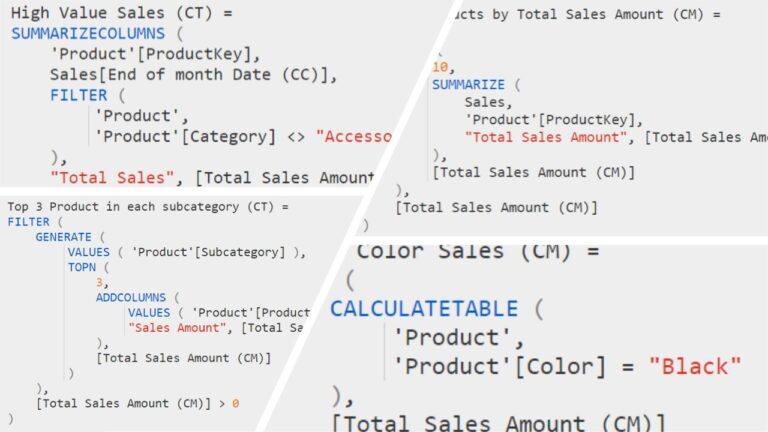Power BI Best Practices and Common Mistakes.
Power BI is one of the most powerful business intelligence platforms available today, but its depth and flexibility can also introduce complexity. Many users—especially those without formal training—encounter common challenges and inefficiencies due to a lack of structured guidance and incomplete understanding of Power BI’s ecosystem.
This article outlines essential best practices and highlights frequent mistakes observed across various business scenarios. Based on hands-on consulting and training experience, Tecrionix shares actionable insights to help organizations improve performance, ensure scalability, and drive more value from their Power BI initiatives.
Think Beyond Ad-Hoc: Adopt a Long-Term Perspective
One of the first mistakes I see is using Power BI purely for ad hoc analysis, without considering the broader needs of stakeholders or future maintenance.
Before building dashboards, ask yourself:
- Who are the end users?
- What decisions need to be made from this dashboard?
- What’s the frequency of usage and data refresh?
- How will future changes be managed?
- Have stakeholders agreed on the layout and KPIs?
Taking a long-term, scalable approach ensures your reports stay relevant, maintainable, and usable by others—not just by you.
Learning Power BI: Go Beyond the Surface
Power BI isn’t just a tool—it’s a complete ecosystem that includes Power Query, DAX, data modeling, visuals, and the Power BI Service.
While self-learning is valuable, it’s best paired with guided, hands-on training to cover every component. In our training programs, we emphasize building solid foundations before jumping into dashboard development.
Mistakes During Data Loading
❌ Pulling Redundant Data
One of the most common issues in Power BI projects is importing unnecessary columns—especially descriptive fields—into fact/data tables. This leads to:
- Slower performance
- Larger PBIX files
- Difficulties with calculated columns and measures
✅ Best Practice: Only import foreign key columns into your data tables. Bring in descriptions through relationships with dimension tables when needed.
Example: Don’t include customer names, regions, or product categories in the fact table. Let your model handle that via lookup tables.
Power Query Pitfalls
❌ Excessive Applied Steps
Transforming data in Power Query is tempting, but unnecessary steps can hurt performance, especially with large datasets.
✅ Best Practice: Do your filtering, sorting, and transformations in the source system or SQL query, not in Power Query—especially when working with millions of rows.
Rule of thumb: If it can be done upstream (in the database or Excel), do it there.
Building a Calendar Table: Do It Right
❌ Using Static Excel Calendars
Beginners often create calendar tables in Excel and import them into Power BI. This works for quick analysis but falls short in production dashboards.
✅ Best Practice: Create a rolling calendar using Power Query or DAX. These are dynamic and automatically extend with time.
📅 Power Query Rolling Calendar Example:
= List.Dates(#date(2015,1,1), Number.From(DateTime.LocalNow()) - Number.From(#date(2015,1,1)), #duration(1,0,0,0))
This gives you a list of dates from Jan 1, 2015, to today—perfect for a dynamic date dimension.
📅 DAX Calendar Table Example:
Calendar = CALENDAR(DATE(2015,1,1), TODAY())
Both methods allow you to build robust, reusable calendar tables.
Dashboard Design Mistakes (and Fixes)
❌ Fancy Visuals Over Clarity
Cool-looking visuals are often harder to interpret. Stick with clean, native visuals that your audience can easily understand.
❌ No Layout Planning
Building a dashboard without a pre-approved layout leads to constant rework.
✅ Best Practice: Share a wireframe or sketch with stakeholders before starting. This saves time and prevents endless redesigns.
❌ Overloading Pages
Trying to fit everything on one page creates clutter.
✅ Limit visuals to 4–6 per page, and use drillthrough or additional tabs if needed.
❌ Using Dark Backgrounds or Distracting Images
Dark themes or background images can reduce readability and increase cognitive load.
✅ Stick to clean, white or light-gray backgrounds with high-contrast text and visuals.
❌ Mixing Dashboards and Reports
Understand the difference:
- Dashboards = high-level, visual summaries
- Reports = detailed, tabular data
Use dashboards for overviews and drillthrough pages for deeper reporting.
Structural and Governance Mistakes
❌ Using One PBIX File for Everything
Don’t build Sales, Inventory, Finance, and HR dashboards in one file.
✅ Create separate PBIX files for each domain and manage them in the same workspace.
❌ Overusing Bookmarks
Bookmarks are useful for storytelling but become hard to maintain when overused—especially on a single page.
✅ Use them wisely and plan ahead.
❌ No Navigation or Home Page
Your dashboard should feel like an app. Include:
- A home page
- Navigation buttons
- Clear visual flow
❌ Hosting on Local Machines
Avoid developing and hosting dashboards on your personal laptop—especially if they require scheduled refresh.
✅ Ask your IT team for a dedicated VM (Virtual Machine) or use cloud services like Azure VM or Power BI Premium. It ensures:
- 24/7 availability
- Better performance
- Easy IT backups
- Stable credentials for scheduled refresh
Final Thoughts
Mastering Power BI requires more than just knowing how to drag visuals onto a canvas. It’s about designing models that scale, creating visuals that communicate effectively, and maintaining dashboards that evolve with your business.
If you’re just getting started, avoid these common pitfalls and build your foundation with best practices. If you’re already using Power BI and seeing performance issues or user dissatisfaction, it might be time for a dashboard health check.
Tecrionix provides expert-driven Power BI consulting and training solutions tailored to the needs of professionals and organizations aiming to elevate their data capabilities. From avoiding common mistakes to mastering advanced concepts like DAX, Power Query, and dynamic data modeling, our services are designed to support scalable, high-performance reporting.
Offering our services across Pakistan, the UAE, Saudi Arabia, Qatar, USA, Canada and other regions, Tecrionix delivers hands-on training programs and end-to-end dashboard development that empower teams to turn data into actionable insights. To explore how our Power BI expertise can enhance your business intelligence strategy, get in touch with us today.





